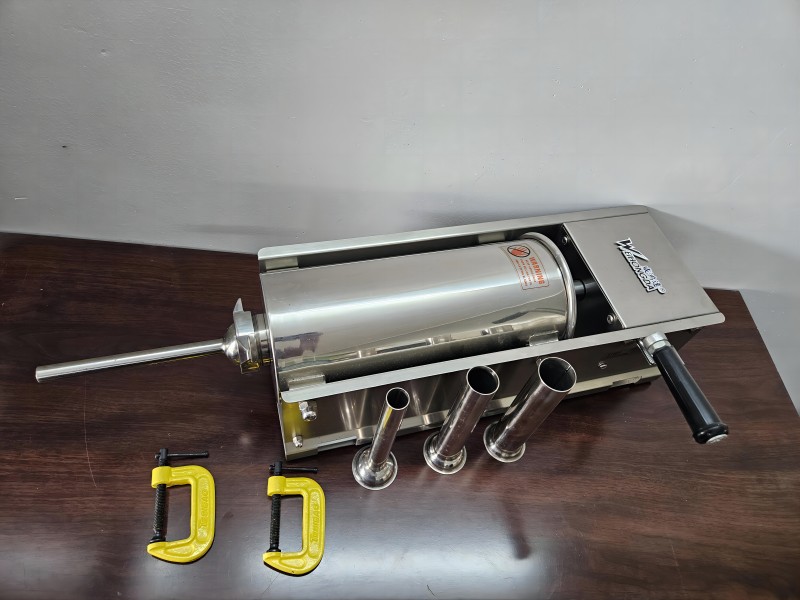Introduction to Sausage Making
Making homemade sausages has become a popular trend among food enthusiasts and home chefs alike. It’s not just about the satisfaction of preparing food yourself, but also the control it gives over the ingredients, flavor, and quality. Whether you’re looking to create traditional recipes or experiment with new flavors, making sausages at home opens up a world of culinary possibilities. You can avoid preservatives, choose your preferred cuts of meat, and get creative with spices. But to get started, it’s essential to have the right tools. Among them, the sausage making machine plays a crucial role in streamlining the process.
Understanding Sausage Making Machines
A sausage making machine is the backbone of your sausage-making journey. These machines simplify the task of filling sausage casings and ensuring the meat mixture is evenly distributed. Sausage making machines come in two main types: manual and electric.
- Manual Sausage Makers are more traditional, requiring hand-cranking to push the meat mixture into the casings. While they offer greater control over the process, they also require more physical effort.
- Electric Sausage Makers, on the other hand, offer automation and ease, making them ideal for larger batches or frequent sausage making. They reduce the workload and produce sausages more quickly than manual machines.
Each type of machine has its advantages depending on your needs, budget, and how often you plan to make sausages.
Key Equipment for Sausage Making
While the sausage making machine is vital, other equipment is equally important to ensure the best results. Here’s a breakdown of the must-have tools for successful sausage making:
- Meat Grinder: This is where it all begins. Grinding meat to the right consistency is essential for making sausages. A good-quality grinder ensures even texture and prevents clogging. Look for a grinder that offers different plate sizes for versatility.
- Sausage Stuffer: Once the meat is ground, the next step is stuffing it into casings. Sausage stuffers come in manual and electric versions, just like sausage makers. Choosing one with a sturdy build and multiple nozzle sizes will give you flexibility in making different types of sausages.
- Mixing and Seasoning Tools: Proper seasoning is key to flavorful sausages. Mixing bowls, spoons, and seasoning containers should be part of your setup to ensure even distribution of spices and ingredients.
- Sausage Casings: Casings can be either natural (derived from animal intestines) or synthetic. Natural casings provide a traditional texture and flavor, while synthetic casings offer consistency and durability. The choice often comes down to personal preference.
Additional Tools that Enhance the Process
In addition to the essential tools, some additional equipment can further enhance your sausage-making experience:
- Digital Thermometer: Sausages need to be cooked to the right temperature to ensure they are safe to eat. A digital thermometer helps you monitor the internal temperature of the sausages, ensuring perfect results every time.
- Kitchen Scale: Precision is crucial in sausage making, especially when measuring ingredients. A kitchen scale ensures you add the correct amounts of meat, fat, and seasonings for a balanced flavor profile.
- Food Processor: While a meat grinder is the go-to for sausage making, a food processor can be a versatile tool for preparing ingredients like garlic, onions, and herbs that go into your sausage mix. It saves time and ensures uniformity.
Cleaning and Maintenance of Sausage Making Machine
Maintaining your equipment is just as important as using it properly. Since sausage making involves raw meat, hygiene is paramount to prevent contamination and ensure food safety.
- Cleaning Sausage Making Machines: After every use, disassemble the machine and thoroughly clean all parts. Pay special attention to the grinder plates and stuffing tubes, as meat particles can get trapped in these areas.
- Tips for Cleaning Other Tools: Make sure to sanitize mixing bowls, spoons, and thermometers. Always follow the manufacturer’s instructions for cleaning electric machines, as water can damage the motor if not handled properly.
A regular cleaning routine will extend the lifespan of your equipment and ensure your sausages are always safe to eat.
Choosing the Right Sausage Making Machine
Selecting the right sausage-making machine can be overwhelming, given the various models available. However, focusing on a few key factors can make the decision easier:
- Size and Capacity: Think about how much sausage you plan to make. Smaller machines are great for occasional use, while larger models are better suited for frequent sausage makers or those making large batches.
- Features: Consider additional features like adjustable nozzles, speed settings, and ease of use. Some machines come with attachments for making different sizes of sausages, giving you versatility in your creations.
- Budget and Brand Recommendations: Some well-known brands in the sausage-making world include LEM, STX International, and Weston. These brands offer a range of machines, from budget-friendly options to professional-grade equipment. Choose a machine that fits both your budget and your needs.
Conclusion: Your Sausage Making Journey Begins Here
The right equipment is the foundation of successful sausage making. From the meat grinder to the sausage stuffer, each tool plays a crucial role in ensuring that the process is smooth, efficient, and enjoyable. With the right sausage-making machine, you can dive into this rewarding culinary craft, experiment with flavors, and impress friends and family with your homemade creations. Sausage making machine allows you to explore endless possibilities in the kitchen, and having the right tools will make your journey both easy and fun. So, why not start today?
FAQs of Sausage Making Machine
- What is the best type of sausage making machine for beginners?
For beginners, an electric sausage maker is usually the best choice due to its ease of use and efficiency. It minimizes manual effort and speeds up the process. - Do I need a meat grinder if I already have a sausage stuffer?
Yes, a meat grinder is essential for preparing the meat mixture. Sausage stuffers only fill casings, while grinders ensure the meat is properly minced and mixed. - How long can homemade sausages be stored?
Fresh homemade sausages can be stored in the refrigerator for up to 3 days or frozen for up to 3 months. Be sure to label and date your sausages for freshness. - Can I make sausages without a machine?
While possible, making sausages without a machine is labor-intensive. Using a manual stuffer or a makeshift funnel can work, but it won’t deliver the same consistency as a machine. - What spices are essential for sausage making?
Common spices include salt, black pepper, garlic, paprika, and fennel seeds. However, the spices you use will depend on the type of sausage you’re making and your personal taste preferences.

